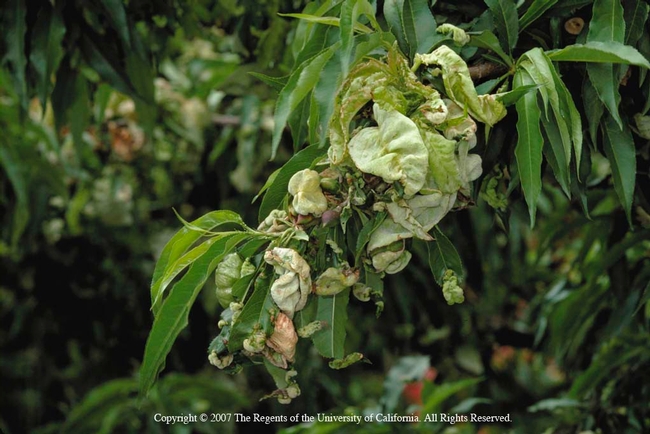Posts Tagged: peach
Thinning Peaches
We have two peach trees (Prunus persica) in our backyard. The old tree, original to the property, is a delicious cling (the flesh adheres to the pit). We are not sure what type of peach it is, but it is still producing fruit. Since the harvest is usually small, we eat these as fast as they ripen. Well, okay, we do share a few of them with family and neighbors. The newer tree is a ‘Red Haven’, which is a freestone (the flesh separates from the pit). Last year my husband grafted an ‘Elberta’ peach onto a branch of this tree and it has fruit for the first time. The newer tree is 13 years old and was one of the first fruit trees we planted in 1999. We have always had a bumper crop of fruit on this tree and our friends, family and neighbors know when it is ‘peach picking time’ at our house. The peaches are firm, sweet and delicious, and ripen early in the season. In years past, we have made peach pies, peach jam, peach syrup ice cream topping, peaches and cream dessert bars, (you get the picture). To get these wonderful peaches, both trees are pruned and fertilized once a year, sprayed twice a year with dormant spray and thinned heavily each year. Most peach trees require 600 to 900 hours of winter chill. Annual pruning renews fruiting wood and encourages fruiting throughout the tree rather than at the ends of weak branches that would break. My husband is very particular about thinning. His goal is to have large, beautiful fruit. It is not unusual for him to fill his wheelbarrow half way full of one inch wide peaches when he is thinning. His motto is to thin 8 to 10 inches apart and he sticks to this method. This dedication pays off with magnificent peaches.
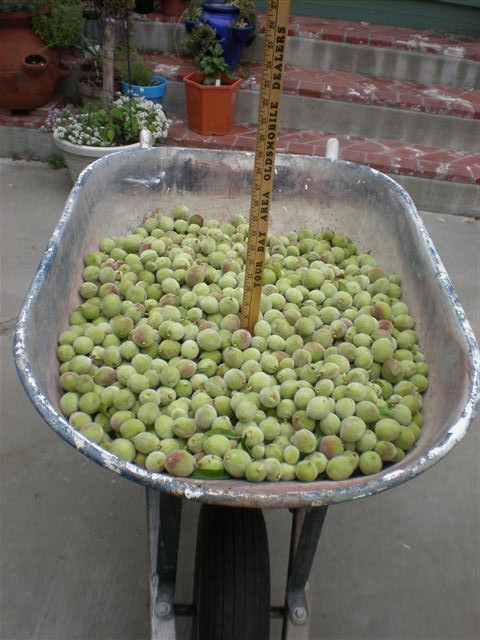
Wheelbarrow full of thinned peaches. (photos by Sharon Rico)
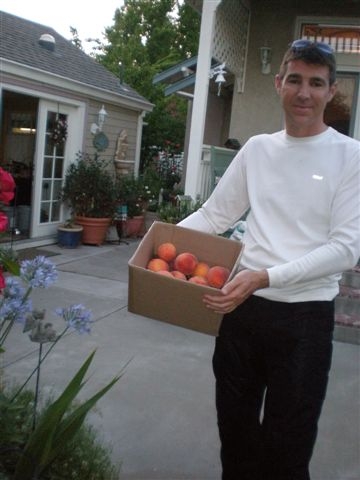
My son Joel with our peaches.
The Inbetween Time
This is a time when the garden should be calling to me, because it’s that ‘in-between’ time, when the hills are golden–hued with crisping grasses and the ticks are nearly gone, and the apples are ready for picking. This year my crop of an as-yet-unidentified ‘Delicious’-type variety was bounteous, but since I did not protect against codling moth infestation, and I did not thin the crop, I have too many apples, many of them small, and many of them with an exit hole besmirched with frass. They are edible, but it’s simpler to just cut the apple in half and find the tunnel from the center and cut out the damage. I’ve never enjoyed the apples, but they are very flavorful this year.
With the winter rains about to start, I need to clean up the beds. This involves raking up dead leaves and fallen petals. I wish I could leave it to rot, and add organic material to my soil. But this cool, moist mulch would provide a wonderful cradle for fungal infections. The roses, hollyhocks and peach tree are particularly vulnerable. The roses are susceptible to black spot and rust, and the hollyhocks, which really don’t belong here in California (but I love their tall stalks and bunches of large open blossoms) develop rust so easily. Cleaning up fallen leaves is just plain sensible.
As for my peach tree, it is highly susceptible to peach leaf curl. I will clean up fallen leaves and I’ll be spraying the entire tree with a copper-based fungicide in early December, when all the leaves are gone. I’ll be mixing up a new batch (or rather my husband will…). Depending on what I can find, it will be a Bordeaux mixture, or an off-the-shelf product. Either way, I hope it will work. I’ll be replacing this tree in the next few years with a resistant variety, because it seems to be a never-ending battle, it is a very old tree and I do love peaches!
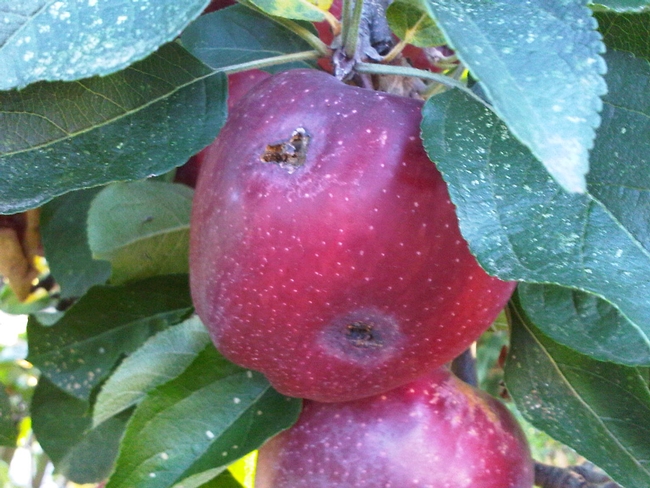
Apple hit with coddling moth. (photo by Riva Flexer)
Fall Treatment for Peach Leaf Curl
Last spring, I noticed that some of the new leaves on my peach tree were distorted. The leaves puckered and curled, then died and fell off. A second set of leaves replaced the fallen leaves and the tree appeared OK. The tree had peach leaf curl (Taphrina deformans). That means that this fall I need to treat the tree so it does not come back in the spring. We did a treatment two years ago and the leaves were OK but I forgot to do it again last fall. Once you have peach leaf curl, it is best to do it every year.
Peach leaf curl is a fungal disease that only affects peach and nectarine trees. Now I need to treat the tree with a fungicide in late fall to prevent leaf curl next spring. Choose a copper-based fungicide, such as tribasic copper sulfate or cupric hydroxide are easiest to use and are most effective if applied with oil. There are several products on the market. Be sure to wait and treat the tree after all the leaves have fallen. When you spray a fungicide, thoroughly cover all branches and twigs so all spores are killed. You may also want to do another treatment in the early spring before any leaves or buds appear. Treatment in the spring after symptoms appear will not be effective.
As with all fungicide applications, be very careful. Wear protective clothing and follow the label directions careful.
Peachy Keen
California peach blossoms are peachy keen. Especially when honey bees are foraging. The pink pastel blossoms, powder blue sky, and golden honey...

Honey Bee and Bumble Bee
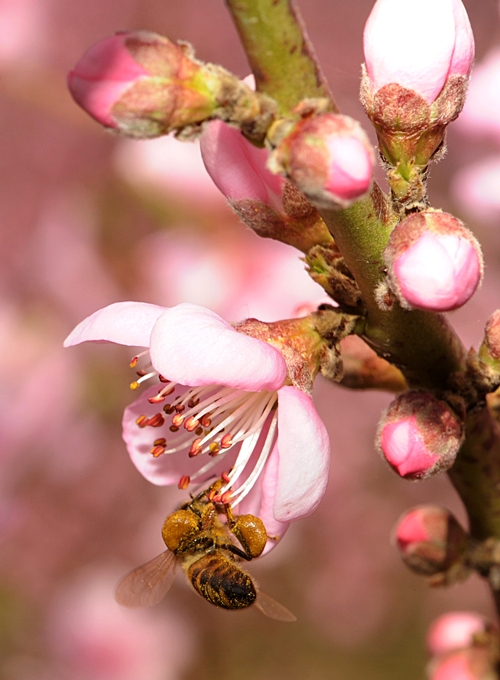
Gathering Pollen
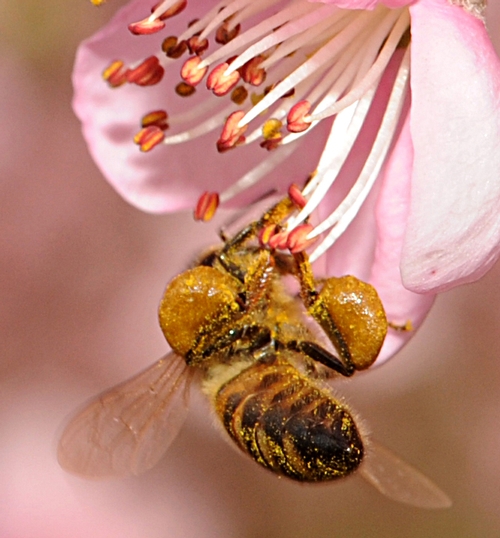
Heavy Load


